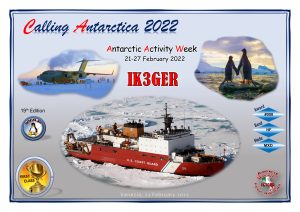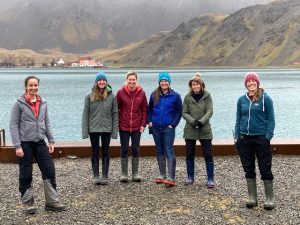 The Italians did participate in the first Antarctic missions mostly as members of expeditions and/or with the support of other Countries.
The Italians did participate in the first Antarctic missions mostly as members of expeditions and/or with the support of other Countries.
Giacomo Bove, at the end of 1800, unsuccessfully sought funding for an Italian Antarctic Expedition and then carried out one in the sub-antarctic islands on behalf of Argentina.
Pierre Dayné, an Alpine scout from the Aosta Valley, was the first Italian to spend the winter in Antarctica. It was the 1903-05 expedition of Jean Baptiste Charcot.
Luigi Bernacchi, was a doctor on the Borchgrevinck expedition. He spent the polar night of the year 1900. Bernacchi was not exactly an Italian but a Tasmanian of Italian origins.
Around the 1950s an Italian film expedition, under the direction of Arturo Gemmiti did work for a while at the Chilean bases.
 Lieutenant Franco Faggioni carried out seismic measurements at Scott Base during the International Geophysical Year of 1957. (See pic aside)
Lieutenant Franco Faggioni carried out seismic measurements at Scott Base during the International Geophysical Year of 1957. (See pic aside)
In the same years, a passionate scholar of the Arctic and Antarctic, Silvio Zavatti, tried to organize a national expedition but the time was not ripe; he managed to visit Bouvet Island anyway. As a scholar and explorer he promoted expeditions to Greenland and Antarctica and in 1958 he developed a program for the construction of a permanent Italian scientific base in the Norwegian Antarctic sector.
We were already in the early 60s when an Italian group of researchers joining the Belgian expedition, performed an ice core drilling in Queen Maud Land.
In 1962, geologist Ardito Desio was able to visit the Dry Valley, near the American McMurdo Base, and also the South Pole Station.
The mountaineer Carlo Mauri also visited Dry Valley a few years later (1967) as a guest of the New Zealand mission.
Between the late 1960s and early 1970s, an enterprising merchant navy officer, Giovanni Ajmone Cat, made two trips from Italy to the Antarctic Peninsula aboard a felucca of which he was the designer and captain, as well as the owner. It was the first time that a vessel flying the Italian flag sailed in Antarctic waters.
Italian sensitivity towards the Antarctic, was therefore maturing in those years and the first institutional interventions began to be recorded: the National Research Council (CNR) organized three interventions, albeit limited in duration and resources, which nevertheless proved to be decisive for the maturation of an Italian government commitment. This would be implemented, with the name of PNRA, in the 1980s. The CNR expeditions, evidently had to rely on the logistics of another country (NZ), they developed in Victoria Land (1968-69, 1972-73 and 1975-76) and had a character that was not only scientific but also mountaineering.
 It was the austral summer of 1975-76 when Renato Cepparo, entrepreneur from Milan, conceived and organized a completely self-sufficient private expedition with the aim of carrying out scientific measurements and building a permanent refuge; fifteen men on board a 900-ton Norwegian ship headed for King George Island (Antarctic Peninsula) and the base, named after Giacomo Bove (See pic aside) was built down there. However, it was short-lived, because shortly afterwards an Argentine military group proceeded to demolish it, perhaps not having appreciated that settlement, in an area subject to national claims!
It was the austral summer of 1975-76 when Renato Cepparo, entrepreneur from Milan, conceived and organized a completely self-sufficient private expedition with the aim of carrying out scientific measurements and building a permanent refuge; fifteen men on board a 900-ton Norwegian ship headed for King George Island (Antarctic Peninsula) and the base, named after Giacomo Bove (See pic aside) was built down there. However, it was short-lived, because shortly afterwards an Argentine military group proceeded to demolish it, perhaps not having appreciated that settlement, in an area subject to national claims!
 Pierre Dayné
Pierre Dayné
The figure of the Italian, Pierre Dayné, an alpine guide from Valsavarenche Aosta Valley, Italy, has been unjustly forgotten for too many years. Pierre Dayné was the only alpine guide of Jean Baptiste Charcot’s French Antarctic expedition from 1903 to 1905.
The series of five postcards published by “TURIN POLAR” and the related postmark issued for the 120th anniversary (1904-2024) celebrating the first Italian in Antarctica, intend to recall the expedition and its ascents following Jean Baptiste Charcot’s mission 1903-1905.
 In 1903, learning that the Nordenskjold expedition was lost in Antarctic waters, Charcot decided to rush to its rescue with the “Francais”, a 32 meter long, 3 masted ship. Its crew was made up of French scientists and sailors with the sole exception of an alpine guide from the Aosta Valley: Pierre Dayné. The ship, having left France on April 31, 1903, docked in Brazil and then reached the mouth of the Rio de la Plata where it underwent repairs from damage suffered during the crossing. Here Charcot learned that the purpose of his voyage was no longer valid since in the meantime, the Nordenskjold expedition had been saved. Charcot nevertheless continued southwards, towards the Strait of Gerlache around which his expedition would take place.
In 1903, learning that the Nordenskjold expedition was lost in Antarctic waters, Charcot decided to rush to its rescue with the “Francais”, a 32 meter long, 3 masted ship. Its crew was made up of French scientists and sailors with the sole exception of an alpine guide from the Aosta Valley: Pierre Dayné. The ship, having left France on April 31, 1903, docked in Brazil and then reached the mouth of the Rio de la Plata where it underwent repairs from damage suffered during the crossing. Here Charcot learned that the purpose of his voyage was no longer valid since in the meantime, the Nordenskjold expedition had been saved. Charcot nevertheless continued southwards, towards the Strait of Gerlache around which his expedition would take place.
 In Dayné’s Alpine Guide booklet we find very interesting attestations issued by Charcot at the end of the 1903-1905 expedition. “The guide Pierre Dayné was part of the French Antarctic expedition that I commanded. I was very satisfied with him from all points of view. Extremely courageous and equipped with exceptional physical strength, he rendered great services on several occasions due to his habit of long marches and glaciers. In particular, 2 beautiful ascents completed in adverse conditions on Wandel Island and Wiencke Island are to be highlighted. We have christened the latter with the name of “Pique Louis de Savoie”. I am very happy to issue him with this certificate. Done in Paris on 18/7/1905
In Dayné’s Alpine Guide booklet we find very interesting attestations issued by Charcot at the end of the 1903-1905 expedition. “The guide Pierre Dayné was part of the French Antarctic expedition that I commanded. I was very satisfied with him from all points of view. Extremely courageous and equipped with exceptional physical strength, he rendered great services on several occasions due to his habit of long marches and glaciers. In particular, 2 beautiful ascents completed in adverse conditions on Wandel Island and Wiencke Island are to be highlighted. We have christened the latter with the name of “Pique Louis de Savoie”. I am very happy to issue him with this certificate. Done in Paris on 18/7/1905
Signed: J.B. Charcot, expedition leader of the French Antarctic expedition “
 And about the climb to Louisi Peak made by Dayné with the naturalist Jabel, Charcot wrote in his logbook: “Finally the two of them reach us exhausted by fatigue because they have been marching for over 22 hours. Pierre says that it was one of the hardest and most dangerous climbs he has ever made. We congratulate them and I decide to give this 1500 m high peak the name of the Duke of the Abruzzi to please Pierre Dayné and to pay homage to the great royal explorer.”
And about the climb to Louisi Peak made by Dayné with the naturalist Jabel, Charcot wrote in his logbook: “Finally the two of them reach us exhausted by fatigue because they have been marching for over 22 hours. Pierre says that it was one of the hardest and most dangerous climbs he has ever made. We congratulate them and I decide to give this 1500 m high peak the name of the Duke of the Abruzzi to please Pierre Dayné and to pay homage to the great royal explorer.”
The first real mountaineering ascents in Antarctica are therefore due to Pierre Dayné and as such, his name deserves to be remembered in the great book of Antarctic explorers.
Pierre Dayné died on March 23, 1936 in Villeneuve. Aosta Valley, Italy.
TNX Giancarlo Poletto for the 5 post cards with philatelic cancellation, scattered & shown in this article

 first made VP8ADE out of (in 1978 approximately). It has a new keyer based on a PIC to replace the original G8AGN diode matrix keyer which broke down.
first made VP8ADE out of (in 1978 approximately). It has a new keyer based on a PIC to replace the original G8AGN diode matrix keyer which broke down.
 antenna used for HF SSB comms with aircraft and sledge parties can also be seen as well as are marine & aeronautical VHF and an Iridium satellite antenna on the tower.
antenna used for HF SSB comms with aircraft and sledge parties can also be seen as well as are marine & aeronautical VHF and an Iridium satellite antenna on the tower. Parts of icy Antarctica are turning green with plant life at an alarming rate as the region is gripped by extreme heat events, according to new research, sparking concerns about the changing landscape on this vast continent.
Parts of icy Antarctica are turning green with plant life at an alarming rate as the region is gripped by extreme heat events, according to new research, sparking concerns about the changing landscape on this vast continent. They found plant life — mostly mosses — had increased in this harsh environment more than 10-fold over the past four decades, according to the study by scientists at the universities of Exeter and Hertfordshire in England, and the British Antarctic Survey, published Friday in the journal Nature Geoscience.
They found plant life — mostly mosses — had increased in this harsh environment more than 10-fold over the past four decades, according to the study by scientists at the universities of Exeter and Hertfordshire in England, and the British Antarctic Survey, published Friday in the journal Nature Geoscience. I
I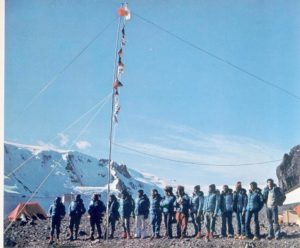 n late 1975, the Italian explorer Renato Cepparo and his 14 crew members were about to embark on a private expedition to Antarctica. The expedition had been given a clearance by the Antarctic Treaty System, and the crew members were prepared to establish Italy’s very first Base in Antarctica.
n late 1975, the Italian explorer Renato Cepparo and his 14 crew members were about to embark on a private expedition to Antarctica. The expedition had been given a clearance by the Antarctic Treaty System, and the crew members were prepared to establish Italy’s very first Base in Antarctica.
 After many vicissitudes, Cepparo’s expedition landed in Antarctica and the Base, was built, this is a fact. The Giacomo Bove Station, named after a 19th century Italian explorer, was inaugurated on January 20th, 1976.
After many vicissitudes, Cepparo’s expedition landed in Antarctica and the Base, was built, this is a fact. The Giacomo Bove Station, named after a 19th century Italian explorer, was inaugurated on January 20th, 1976. The evidence says that Argentina did destroy Giacomo Bove Station when in September of 1976, they sent an icebreaker to the South Shetland Islands to tear down the newly inaugurated Base. In the middle of the Antarctic winter, the Argentians did take the Base off in the same time it had taken to construct: three to four days. The materials, which had just arrived in Antarctica, were transported back to Buenos Aires. Prof. Fabbri strongly believe that, some if it, either hidden or forgotten, is still stored in a military facility in the Argentinian capital.
The evidence says that Argentina did destroy Giacomo Bove Station when in September of 1976, they sent an icebreaker to the South Shetland Islands to tear down the newly inaugurated Base. In the middle of the Antarctic winter, the Argentians did take the Base off in the same time it had taken to construct: three to four days. The materials, which had just arrived in Antarctica, were transported back to Buenos Aires. Prof. Fabbri strongly believe that, some if it, either hidden or forgotten, is still stored in a military facility in the Argentinian capital. As a day job, Julius Fabbri (IV3CCT-II3BOVE) teaches science at a high school in Trieste, a city in northeastern Italy, but since he was young his hobby has been to be a radio operator. And in the Italian hobbyist radio operator community the story of Renato Cepparo’s Antarctic mission, a story that is otherwise not well-known, has become legendary.
As a day job, Julius Fabbri (IV3CCT-II3BOVE) teaches science at a high school in Trieste, a city in northeastern Italy, but since he was young his hobby has been to be a radio operator. And in the Italian hobbyist radio operator community the story of Renato Cepparo’s Antarctic mission, a story that is otherwise not well-known, has become legendary. Back in 2008, for instance, as a project in his science class, Prof. Fabbri and his students built a full-scale model of the ruins of Giacomo Bove Base, and a few years later, he helped design a virtual 3D model of it.
Back in 2008, for instance, as a project in his science class, Prof. Fabbri and his students built a full-scale model of the ruins of Giacomo Bove Base, and a few years later, he helped design a virtual 3D model of it. The first days of spring in the Antarctic: for over a month, the island of Galindez has been almost completely packed with ice
The first days of spring in the Antarctic: for over a month, the island of Galindez has been almost completely packed with ice Sea ice plays an important role in the Antarctic ecosystem. It acts as a “blanket” that separates the ocean from the atmosphere. In addition to blocking sunlight from entering the water and reflecting it, the ice also traps the heat in the ocean, preventing it from heating the air.
Sea ice plays an important role in the Antarctic ecosystem. It acts as a “blanket” that separates the ocean from the atmosphere. In addition to blocking sunlight from entering the water and reflecting it, the ice also traps the heat in the ocean, preventing it from heating the air. A mid-July, minor Sudden Stratospheric Warming event saw the vortex become elongated, weaker, wobbly. This stratospheric anomaly affected tropospheric weather patterns, but now appears to be easing. In late July and early August, a rapid stratosphere-troposphere coupling contributed to the development of a major high pressure cell and heatwave over Antarctica, while a very deep low formed over the Southern Ocean, and a heat dome affected Australia. It was associated with relatively cool conditons in Chile and Argentina.
A mid-July, minor Sudden Stratospheric Warming event saw the vortex become elongated, weaker, wobbly. This stratospheric anomaly affected tropospheric weather patterns, but now appears to be easing. In late July and early August, a rapid stratosphere-troposphere coupling contributed to the development of a major high pressure cell and heatwave over Antarctica, while a very deep low formed over the Southern Ocean, and a heat dome affected Australia. It was associated with relatively cool conditons in Chile and Argentina. Leidos is the prime contractor supporting the U.S. Antarctic Program (
Leidos is the prime contractor supporting the U.S. Antarctic Program ( ASC is celebrating the many aircraft that it relies on to support the
ASC is celebrating the many aircraft that it relies on to support the  Now in the Northern hemisphere it’s almost summertime, the ideal period to travel to the northern latitude while in about 6 months time, it will be better heading to the South Pole.
Now in the Northern hemisphere it’s almost summertime, the ideal period to travel to the northern latitude while in about 6 months time, it will be better heading to the South Pole. The measure is part of a newly published “Conservation Management Plan” (
The measure is part of a newly published “Conservation Management Plan” ( George Island by air.
George Island by air.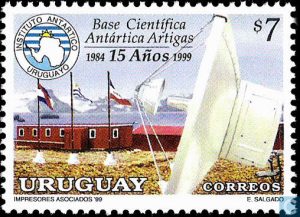 coexist in this place where the development of science is the priority. Uruguay is present in the area and has been part of the Antarctic Treaty for 40 years. El País traveled to Antarctica in February 2024 to learn first-hand how the Artigas Antarctic Scientific Base works, who travels to that place, why Uruguay has a presence and how people live on this Continent.
coexist in this place where the development of science is the priority. Uruguay is present in the area and has been part of the Antarctic Treaty for 40 years. El País traveled to Antarctica in February 2024 to learn first-hand how the Artigas Antarctic Scientific Base works, who travels to that place, why Uruguay has a presence and how people live on this Continent. The author of this article tells one story from its rich history. Roald Amundsen is probably most famous for being the first to reach the South Pole in the ‘race’ against Robert Falcon Scott. Tragically, Scott and his companions died in their attempt. While they were still trudging through the snow, Amundsen had completed his mission and returned to his base camp, boarded his ship, Fram, and headed back to Hobart.
The author of this article tells one story from its rich history. Roald Amundsen is probably most famous for being the first to reach the South Pole in the ‘race’ against Robert Falcon Scott. Tragically, Scott and his companions died in their attempt. While they were still trudging through the snow, Amundsen had completed his mission and returned to his base camp, boarded his ship, Fram, and headed back to Hobart.
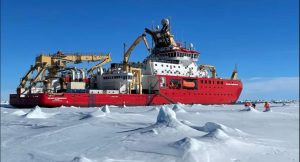 Climate researchers on board the RRS Sir David Attenborough have described their latest polar expedition as “really successful”.
Climate researchers on board the RRS Sir David Attenborough have described their latest polar expedition as “really successful”. WAP Antarctic Bulletin nr. 302, released on Febr. 18th 2024 is available online with last info and reported activity from Antarctica.
WAP Antarctic Bulletin nr. 302, released on Febr. 18th 2024 is available online with last info and reported activity from Antarctica.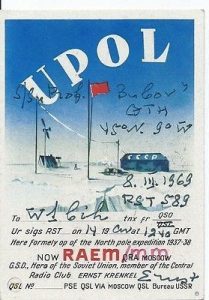 In the summer of 1924 Ernst Krenkel went to Leningrad with what little money he had saved, hoping to find employment as the radio operator on any ship undertaking a long voyage. At that time, only specially designated Soviet vessels went on long voyages, and in Leningrad there were already qualified naval radio operators without work. Just when Krenkel had given up all hope of finding work he was told that the hydrographic management bureau was in urgent need of a radio operator prepared to go on any expedition, to any island in the Arctic ocean. There was little interest because the pay was poor and it was necessary to be away for the whole year, living in ‘hellish’ conditions.
In the summer of 1924 Ernst Krenkel went to Leningrad with what little money he had saved, hoping to find employment as the radio operator on any ship undertaking a long voyage. At that time, only specially designated Soviet vessels went on long voyages, and in Leningrad there were already qualified naval radio operators without work. Just when Krenkel had given up all hope of finding work he was told that the hydrographic management bureau was in urgent need of a radio operator prepared to go on any expedition, to any island in the Arctic ocean. There was little interest because the pay was poor and it was necessary to be away for the whole year, living in ‘hellish’ conditions. wearing his new naval uniform he set off by train to Arkhangelsk (Archangel). On arrival he was assigned to the “ Yugorski Shar “ which was preparing to take the relief crew to the first Soviet polar observatory “Matochkin Shar”, constructed the year before on the northern coast of the Matochkin Shar strait of the Novaya Zemlya archipelago.
wearing his new naval uniform he set off by train to Arkhangelsk (Archangel). On arrival he was assigned to the “ Yugorski Shar “ which was preparing to take the relief crew to the first Soviet polar observatory “Matochkin Shar”, constructed the year before on the northern coast of the Matochkin Shar strait of the Novaya Zemlya archipelago. Ham radio was born in the USSR and Ernst Krenkel was delighted. Soon he was on-air using homebrew equipment, with the callsign EU2EQ (later U3AA).
Ham radio was born in the USSR and Ernst Krenkel was delighted. Soon he was on-air using homebrew equipment, with the callsign EU2EQ (later U3AA).
 Hi folks,
Hi folks,
 While waiting two years and three months to be rescued when their sloop Favorite was shipwrecked at Kerguelen in 1825, the British sealer and cartographer John Nunn and his crew spent some miserable months trying to survive on Saddle Island (now called Ile de l’Ouest) at 49°17’59” South, 70°31’56” East, buffeted by the merciless westerly winds.
While waiting two years and three months to be rescued when their sloop Favorite was shipwrecked at Kerguelen in 1825, the British sealer and cartographer John Nunn and his crew spent some miserable months trying to survive on Saddle Island (now called Ile de l’Ouest) at 49°17’59” South, 70°31’56” East, buffeted by the merciless westerly winds.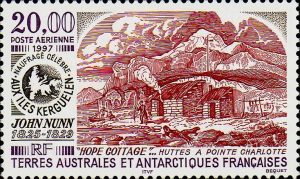 The group was finally spotted in 1827 by Captain Alexander Distant on the schooner Sprightly, belonging to the celebrated shipowner Enderby of London. Nunn and his crewmates joined the Sprightly in hunting whales and elephant seals until 25 March 1829, at which point they were finally returned to Harwich, England four years after the shipwreck.
The group was finally spotted in 1827 by Captain Alexander Distant on the schooner Sprightly, belonging to the celebrated shipowner Enderby of London. Nunn and his crewmates joined the Sprightly in hunting whales and elephant seals until 25 March 1829, at which point they were finally returned to Harwich, England four years after the shipwreck. Interesting is the chart provided by
Interesting is the chart provided by 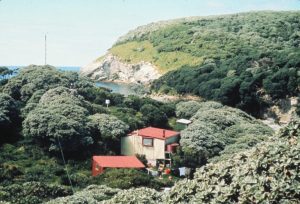
 WAP wish the readers a Wonderful Easter time
WAP wish the readers a Wonderful Easter time
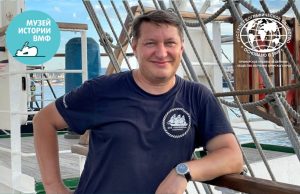 Valery Sushkov RW3GW is an Old Timer DXpeditionner and actual President of the Russian Robinson Club (
Valery Sushkov RW3GW is an Old Timer DXpeditionner and actual President of the Russian Robinson Club (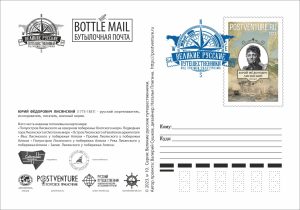 Society, Society for the Study of the Amur Territory, member of the Union of Journalists of Russia, laureate of the National Prizes of the Russian Geographical Society “Crystal Compass”
Society, Society for the Study of the Amur Territory, member of the Union of Journalists of Russia, laureate of the National Prizes of the Russian Geographical Society “Crystal Compass”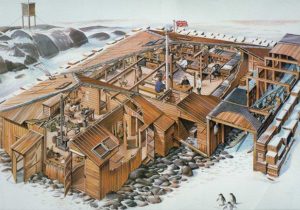 The Replica Museum is a boutique, world class museum providing visitors with the opportunity to learn and understand the history and achievements of the men of the 1911-14 Australasian Antarctic Expedition led by Douglas Mawson.
The Replica Museum is a boutique, world class museum providing visitors with the opportunity to learn and understand the history and achievements of the men of the 1911-14 Australasian Antarctic Expedition led by Douglas Mawson. Project Blizzard aimed to increase public awareness of Australia’s involvement in Antarctica and, in doing so, conserve Mawson’s Huts. In particular, viewed the scientific work, including meteorological, biological, geological and magnetic research of the AAE, as significant. The organization immediately began to look for financial support from the community, hoping to raise capital for a privately-funded Antarctic expedition. The campaign used the slogan ‘Buy a board for Mawson’s Hut’.
Project Blizzard aimed to increase public awareness of Australia’s involvement in Antarctica and, in doing so, conserve Mawson’s Huts. In particular, viewed the scientific work, including meteorological, biological, geological and magnetic research of the AAE, as significant. The organization immediately began to look for financial support from the community, hoping to raise capital for a privately-funded Antarctic expedition. The campaign used the slogan ‘Buy a board for Mawson’s Hut’. In 1985/86, they focused on stabilising the internal platform of the Main Hut, which had partly collapsed under the load of snow ingress, using metal and timber props. This work involved an associated archaeological excavation program in areas disturbed for the works.
In 1985/86, they focused on stabilising the internal platform of the Main Hut, which had partly collapsed under the load of snow ingress, using metal and timber props. This work involved an associated archaeological excavation program in areas disturbed for the works. After six days of activities on the White Continent, a new version of the Antarctic School Expedition (EAE) organized by the Chilean Antarctic Institute (
After six days of activities on the White Continent, a new version of the Antarctic School Expedition (EAE) organized by the Chilean Antarctic Institute (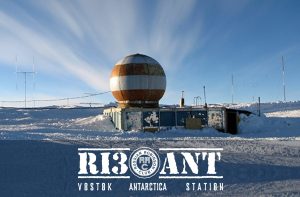 To celebrate the 30th Anniversary of Russian Robinson Club (RRC) a Special callsign RI3ØANT will operate from Vostok Base (
To celebrate the 30th Anniversary of Russian Robinson Club (RRC) a Special callsign RI3ØANT will operate from Vostok Base (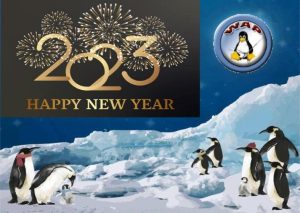
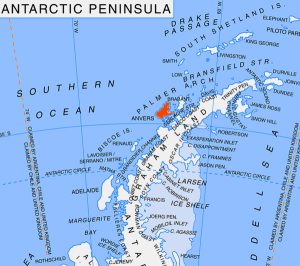 The larval health of an Antarctic cold-water coral species may be resistant to warming water temperatures, a University of Maine study finds, bringing new hope for the climate change resilience of deep-sea ecosystems in the Western Antarctic Peninsula.
The larval health of an Antarctic cold-water coral species may be resistant to warming water temperatures, a University of Maine study finds, bringing new hope for the climate change resilience of deep-sea ecosystems in the Western Antarctic Peninsula.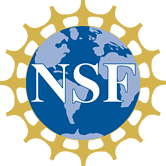 “Although their habitat is now changing faster than other places around the world, most marine animals in the Southern Ocean are thought to have a limited capacity to adapt to environmental shifts,” says Julia Johnstone, principal author of the study. “Especially during the larval stage, when developmental processes are organizing and laying the foundations for key life-long functions like prey capture and growth, those environmental changes can have an outsize impact.”
“Although their habitat is now changing faster than other places around the world, most marine animals in the Southern Ocean are thought to have a limited capacity to adapt to environmental shifts,” says Julia Johnstone, principal author of the study. “Especially during the larval stage, when developmental processes are organizing and laying the foundations for key life-long functions like prey capture and growth, those environmental changes can have an outsize impact.”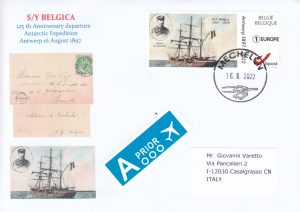 Monday August 16 , 897. The port of Antwerp is filled with people. The National Anthem is being played, canon shots of joy are heard across the River. The Belgica leaves the harbour, setting sail to Antarctica. Other than a lost whaler, there has never been a soul nearby…
Monday August 16 , 897. The port of Antwerp is filled with people. The National Anthem is being played, canon shots of joy are heard across the River. The Belgica leaves the harbour, setting sail to Antarctica. Other than a lost whaler, there has never been a soul nearby… The Belgian Antarctic Expedition of 1897–1899 was the first expedition to winter in the Antarctic region. Led by Adrien de Gerlache de Gomery aboard the R/V Belgica, it was the first Belgian Antarctic expedition and is considered the first expedition of the Heroic Age of Antarctic Exploration. Among its members were Frederick Cook and Roald Amundsen, explorers who would later attempt the respective conquests of the North and South Poles.
The Belgian Antarctic Expedition of 1897–1899 was the first expedition to winter in the Antarctic region. Led by Adrien de Gerlache de Gomery aboard the R/V Belgica, it was the first Belgian Antarctic expedition and is considered the first expedition of the Heroic Age of Antarctic Exploration. Among its members were Frederick Cook and Roald Amundsen, explorers who would later attempt the respective conquests of the North and South Poles.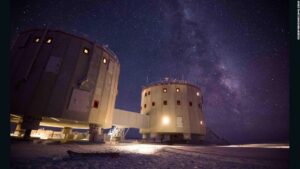 ESA-sponsored medical doctor Hannes Hagson snapped this picture from the Station’s front door in early on 5 August. “Time here has the strange quality of both passing really quickly and very slowly at the same time,” he shared, “and in just two days we expect the return of the sun to grace us here at 75 degrees south! The returning daylight certainly has us all cheered up and starting to sense the beginning of the final part of this adventure.”
ESA-sponsored medical doctor Hannes Hagson snapped this picture from the Station’s front door in early on 5 August. “Time here has the strange quality of both passing really quickly and very slowly at the same time,” he shared, “and in just two days we expect the return of the sun to grace us here at 75 degrees south! The returning daylight certainly has us all cheered up and starting to sense the beginning of the final part of this adventure.” Of course, it’s not all fun and games. Hannes has been busy with biomedical research, as he continues to gather data from crew urine, stool and blood samples, as well as cognitive and psychological measures through questionnaires to study the effects of isolated, confined and extreme environments on the human body.
Of course, it’s not all fun and games. Hannes has been busy with biomedical research, as he continues to gather data from crew urine, stool and blood samples, as well as cognitive and psychological measures through questionnaires to study the effects of isolated, confined and extreme environments on the human body. Something interesting has been publish recently on the web. Here an abstract:
Something interesting has been publish recently on the web. Here an abstract: 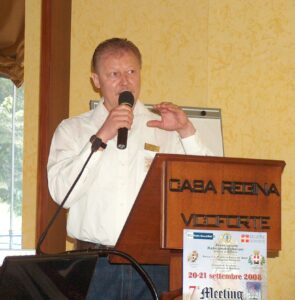 A very interesting pubblication, signed by Dr. Volker Strecke, DL8JDX, Antarctic veteran has been recentry pubblished on the german journal
A very interesting pubblication, signed by Dr. Volker Strecke, DL8JDX, Antarctic veteran has been recentry pubblished on the german journal 
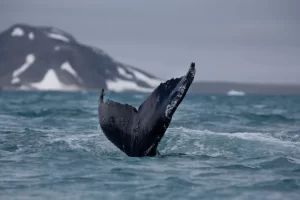 Now, for the first time, a research team has been able to show systematically that the fin whale population is recovering. The findings were published in the journal Scientific Reports.
Now, for the first time, a research team has been able to show systematically that the fin whale population is recovering. The findings were published in the journal Scientific Reports.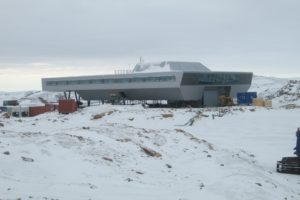 The Bill is introduced to “provide for the national measures for protecting the Antarctic environment and dependent and associated ecosystems and to give effect to the Antarctic Treaty, the Convention on the Conservation of Antarctic Marine Living Resources and to the Protocol on Environmental Protection to the Antarctic Treaty and for matters connected therewith or incidental thereto”.
The Bill is introduced to “provide for the national measures for protecting the Antarctic environment and dependent and associated ecosystems and to give effect to the Antarctic Treaty, the Convention on the Conservation of Antarctic Marine Living Resources and to the Protocol on Environmental Protection to the Antarctic Treaty and for matters connected therewith or incidental thereto”. India signed the Antarctic Treaty on August 19, 1983, and was soon granted the observer status on September 12, 1983. The protocol entered into force for India on January 14, 1998. India has active research stations Maitri (
India signed the Antarctic Treaty on August 19, 1983, and was soon granted the observer status on September 12, 1983. The protocol entered into force for India on January 14, 1998. India has active research stations Maitri ( After months of preparation, a crew of 12 scientists, explorers, and staff at Europe’s Concordia Research Station in Antarctica (
After months of preparation, a crew of 12 scientists, explorers, and staff at Europe’s Concordia Research Station in Antarctica (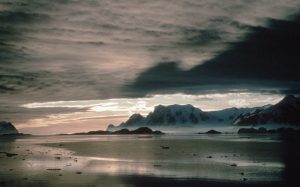 Clouds come in myriad shapes, sizes and types, which control their effects on climate. New research led by the University of Washington shows that the splintering of frozen liquid droplets to form ice shards inside Southern Ocean clouds dramatically affects the clouds’ ability to reflect sunlight back to space.
Clouds come in myriad shapes, sizes and types, which control their effects on climate. New research led by the University of Washington shows that the splintering of frozen liquid droplets to form ice shards inside Southern Ocean clouds dramatically affects the clouds’ ability to reflect sunlight back to space.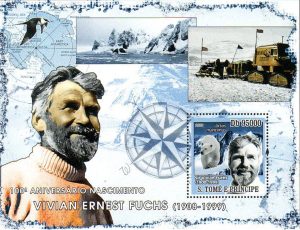 Sir Vivian Ernest Fuchs (11 February 1908 – 11 November 1999) was an English explorer. Fuchs is best known as the leader of the Commonwealth Trans-Antarctic Expedition, a Commonwealth-sponsored expedition that completed the first overland crossing of Antarctica via the South Pole in 1958
Sir Vivian Ernest Fuchs (11 February 1908 – 11 November 1999) was an English explorer. Fuchs is best known as the leader of the Commonwealth Trans-Antarctic Expedition, a Commonwealth-sponsored expedition that completed the first overland crossing of Antarctica via the South Pole in 1958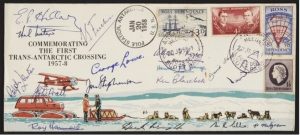 In 1958, Fuchs was knighted by Queen Elizabeth II. He co-wrote, with Sir Edmund Hillary The Crossing of Antarctica. In 1959 he was awarded the Hans Edge Medal by the Royal Danish Geographical Society.
In 1958, Fuchs was knighted by Queen Elizabeth II. He co-wrote, with Sir Edmund Hillary The Crossing of Antarctica. In 1959 he was awarded the Hans Edge Medal by the Royal Danish Geographical Society.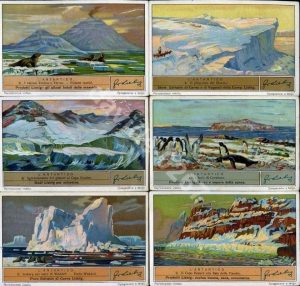 A friend, sent
A friend, sent  Professor Arif Herekar, Professor of Neurology together with excelling in his professional duties is a passionate traveller and globe trotter. He happens to be one of the few Pakistanis to step on to the Antarctic soil, probably the only Pakistani certified as an Antarctic naval seal camping on the Antarctic continent has made this beautiful country Pakistan proud by hoisting the national flag on the Antarctic soil.
Professor Arif Herekar, Professor of Neurology together with excelling in his professional duties is a passionate traveller and globe trotter. He happens to be one of the few Pakistanis to step on to the Antarctic soil, probably the only Pakistani certified as an Antarctic naval seal camping on the Antarctic continent has made this beautiful country Pakistan proud by hoisting the national flag on the Antarctic soil. While on April 25th the world celebrates the penguins, it’s also a time to think about saving them. Many penguin colonies have been lost to climate change and it’s estimated that half the population of emperor penguins will vanish by the end of this century.
While on April 25th the world celebrates the penguins, it’s also a time to think about saving them. Many penguin colonies have been lost to climate change and it’s estimated that half the population of emperor penguins will vanish by the end of this century.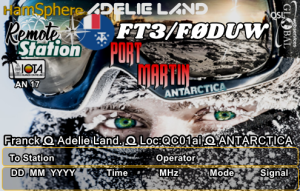
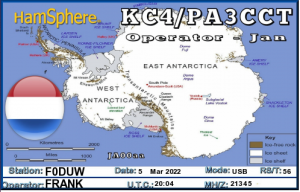 The TX and antenna are for exemple, located in Antarctica but the operator is, for exemple, in Paris. The propagation in Antarctica will be the same of real Amateur Radio. We have dirctional antenna and 100 watts.
The TX and antenna are for exemple, located in Antarctica but the operator is, for exemple, in Paris. The propagation in Antarctica will be the same of real Amateur Radio. We have dirctional antenna and 100 watts.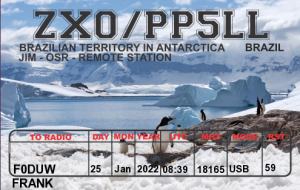 We personally didn’t know that, and now we understood that HamSphere is a subscription-based internet service which simulates Amteur Radio communication over the Internet as designed by Kelly Lindman, 5B4AIT.
We personally didn’t know that, and now we understood that HamSphere is a subscription-based internet service which simulates Amteur Radio communication over the Internet as designed by Kelly Lindman, 5B4AIT.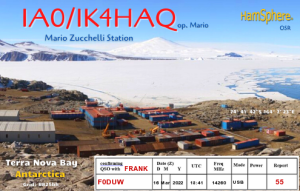

 The small branch with its colors, gives hope to all hearts.
The small branch with its colors, gives hope to all hearts. 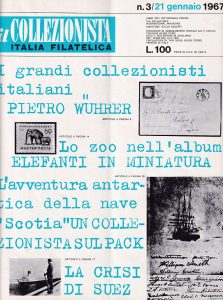 An old copy of “Il Collezionista” an Italian Philatelic Magazine (Jan. 1967) reports a bit of story of the famous Ship Scotia which was depicted on a stamp issued by the Falkland Islands, Scotia was also depicted on two stamps issued by the British Antarctic Territory.
An old copy of “Il Collezionista” an Italian Philatelic Magazine (Jan. 1967) reports a bit of story of the famous Ship Scotia which was depicted on a stamp issued by the Falkland Islands, Scotia was also depicted on two stamps issued by the British Antarctic Territory.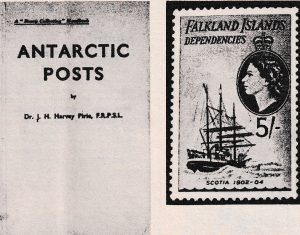 former medical student from University of Edinburg who organised and led the Scottish National Antarctic Expedition (SNAE) from 1902 to1904
former medical student from University of Edinburg who organised and led the Scottish National Antarctic Expedition (SNAE) from 1902 to1904 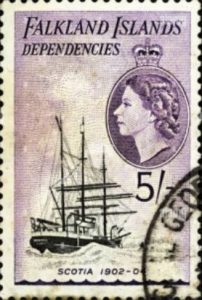 Scotia overwintered in Scotia Bay where she was frozen in for eight months. She departed for the Falkland Islands on 27 November en route for Buenos Aires, Argentina where she underwent a refit. Scotia returned to Laurie Island on 14 February 1904, sailing eight days later for the Weddel Sea. She departed from the Antarctic on 21 March. Calling at Saint Helena in June, she arrived at Millport, Cumbrae, Ayrishire on 21 July, and was escorted by a number of ships to her final destination of Gourock Renfrewshire.
Scotia overwintered in Scotia Bay where she was frozen in for eight months. She departed for the Falkland Islands on 27 November en route for Buenos Aires, Argentina where she underwent a refit. Scotia returned to Laurie Island on 14 February 1904, sailing eight days later for the Weddel Sea. She departed from the Antarctic on 21 March. Calling at Saint Helena in June, she arrived at Millport, Cumbrae, Ayrishire on 21 July, and was escorted by a number of ships to her final destination of Gourock Renfrewshire. On
On 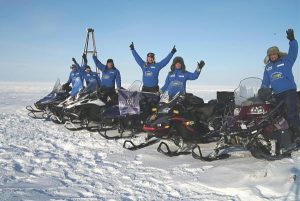 The polar snowmobile expedition R15ØWS from the
The polar snowmobile expedition R15ØWS from the 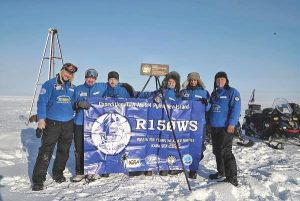 The Team, included Igor Znamensky UA9KDF (Tarko-Sale, YNAO), Andrey Korobeinikov UA9LDD (Tyumen), Andrey Moiseev UAØBA (Norilsk), Viktor Kuzyakin RWØBG (Norilsk), Alexey Bystrov RT9K (Dudinka) and Andrey Prudnikov RT9K (Surgut) did travel 2980 km on snowmobiles to the island and back. During four days of work on air R15ØWS made 5635 QSOs. Of these: CW – 3294, SSB – 1323, FT8 – 1018, 20m – 2878, 30m – 609, 40m – 489, 15m – 570, 12m – 8, 17m – 1072.
The Team, included Igor Znamensky UA9KDF (Tarko-Sale, YNAO), Andrey Korobeinikov UA9LDD (Tyumen), Andrey Moiseev UAØBA (Norilsk), Viktor Kuzyakin RWØBG (Norilsk), Alexey Bystrov RT9K (Dudinka) and Andrey Prudnikov RT9K (Surgut) did travel 2980 km on snowmobiles to the island and back. During four days of work on air R15ØWS made 5635 QSOs. Of these: CW – 3294, SSB – 1323, FT8 – 1018, 20m – 2878, 30m – 609, 40m – 489, 15m – 570, 12m – 8, 17m – 1072. Rykachev, Director of the main geophysical observatory, in honor of the 150th anniversary of the creation of the Russian weather service,
Rykachev, Director of the main geophysical observatory, in honor of the 150th anniversary of the creation of the Russian weather service,
 This event is completely unprecedented and upended our expectations about the Antarctic climate system,’ one expert said
This event is completely unprecedented and upended our expectations about the Antarctic climate system,’ one expert said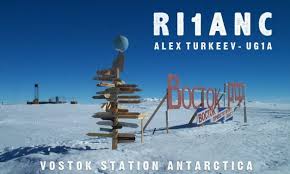 (WAP RUS-14)— at the center of the eastern ice sheet — is around minus-63 (minus-53 Celsius) in March. But on Friday, the temperature leaped to zero (minus-17.7 Celsius), the warmest it’s been there during March since record keeping began 65 years ago. It broke the previous monthly record by a staggering 27 degrees (15 Celsius).
(WAP RUS-14)— at the center of the eastern ice sheet — is around minus-63 (minus-53 Celsius) in March. But on Friday, the temperature leaped to zero (minus-17.7 Celsius), the warmest it’s been there during March since record keeping began 65 years ago. It broke the previous monthly record by a staggering 27 degrees (15 Celsius).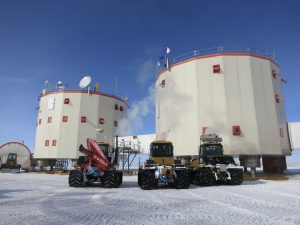 Vostok, a Russian meteorological observatory, is about 808 miles from the South Pole and sits 11,444 feet above sea level. It’s famous for holding the lowest temperature ever observed on Earth: minus-128.6 degrees (minus-89.2 Celsius), set on July 21, 1983.
Vostok, a Russian meteorological observatory, is about 808 miles from the South Pole and sits 11,444 feet above sea level. It’s famous for holding the lowest temperature ever observed on Earth: minus-128.6 degrees (minus-89.2 Celsius), set on July 21, 1983.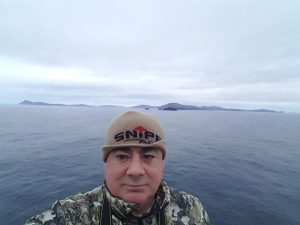 From Cap. Eduardo Abril de Fontcuberta EA4GKV/EO4HAG WAP-242
From Cap. Eduardo Abril de Fontcuberta EA4GKV/EO4HAG WAP-242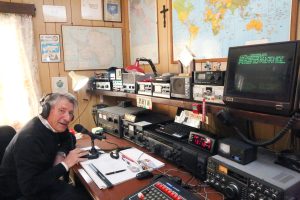 From Gianni I1HYW/IR1ANT WAP ØØ2
From Gianni I1HYW/IR1ANT WAP ØØ2